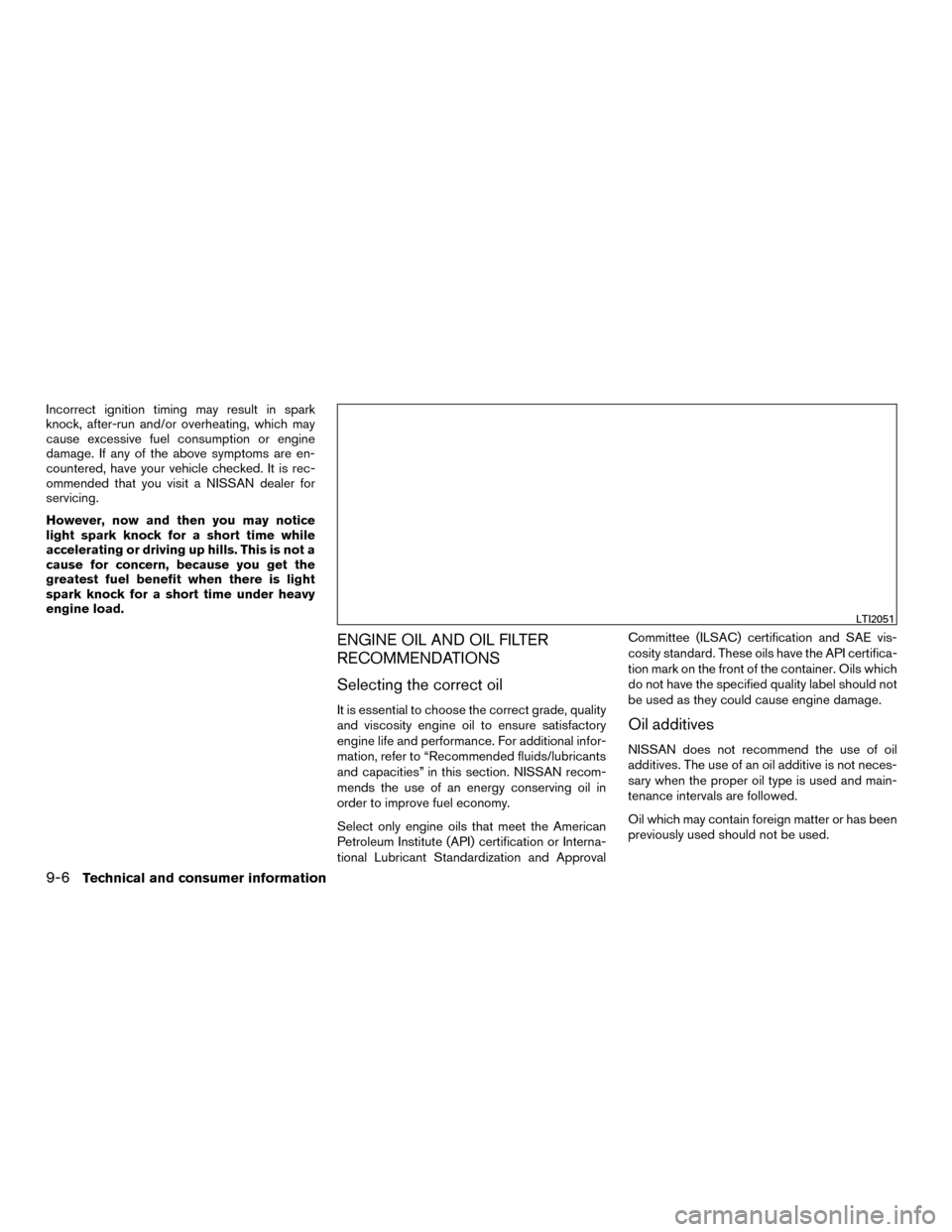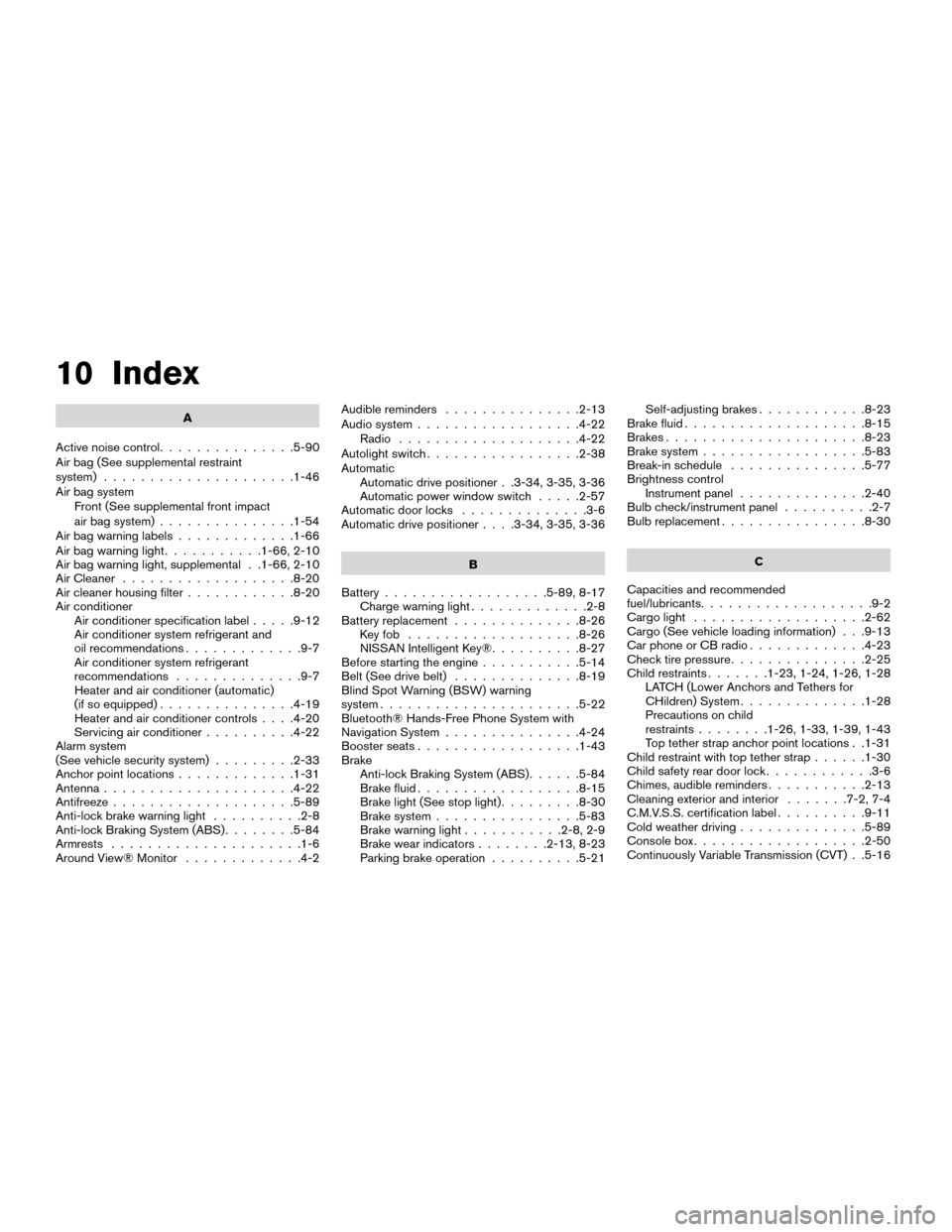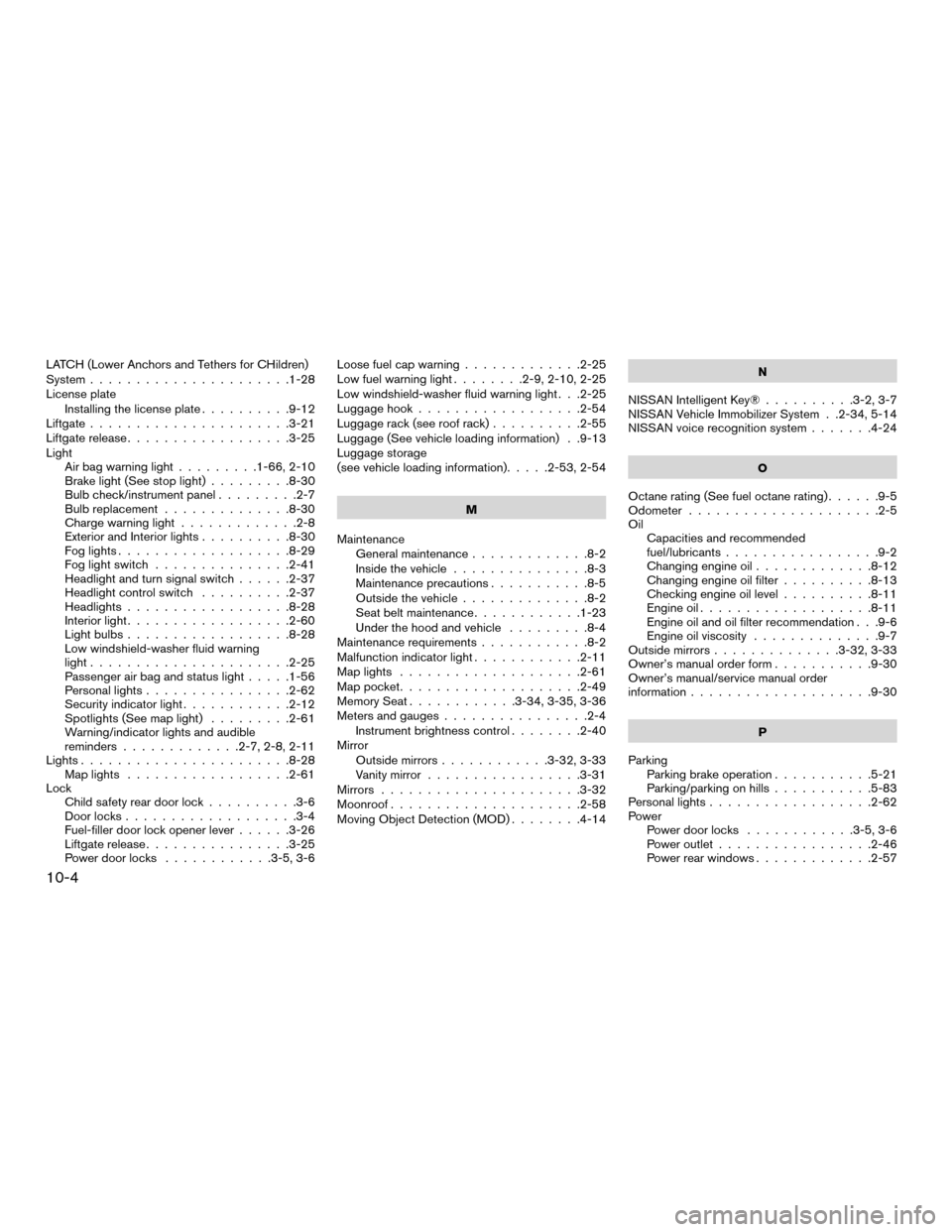2016 NISSAN MURANO HYBRID check oil
[x] Cancel search: check oilPage 395 of 443

Incorrect ignition timing may result in spark
knock, after-run and/or overheating, which may
cause excessive fuel consumption or engine
damage. If any of the above symptoms are en-
countered, have your vehicle checked. It is rec-
ommended that you visit a NISSAN dealer for
servicing.
However, now and then you may notice
light spark knock for a short time while
accelerating or driving up hills. This is not a
cause for concern, because you get the
greatest fuel benefit when there is light
spark knock for a short time under heavy
engine load.
ENGINE OIL AND OIL FILTER
RECOMMENDATIONS
Selecting the correct oil
It is essential to choose the correct grade, quality
and viscosity engine oil to ensure satisfactory
engine life and performance. For additional infor-
mation, refer to “Recommended fluids/lubricants
and capacities” in this section. NISSAN recom-
mends the use of an energy conserving oil in
order to improve fuel economy.
Select only engine oils that meet the American
Petroleum Institute (API) certification or Interna-
tional Lubricant Standardization and ApprovalCommittee (ILSAC) certification and SAE vis-
cosity standard. These oils have the API certifica-
tion mark on the front of the container. Oils which
do not have the specified quality label should not
be used as they could cause engine damage.Oil additives
NISSAN does not recommend the use of oil
additives. The use of an oil additive is not neces-
sary when the proper oil type is used and main-
tenance intervals are followed.
Oil which may contain foreign matter or has been
previously used should not be used.
LTI2051
9-6Technical and consumer information
Page 414 of 443

3. Try to rearrange the trailer load so it is bal-anced as described in this section.
● Be careful when passing other vehicles.
Passing while towing a trailer requires con-
siderably more distance than normal pass-
ing. Remember, the length of the trailer must
also pass the other vehicle before you can
safely change lanes.
● Downshift the transmission to a lower gear
for engine braking when driving down steep
or long hills. This will help slow the vehicle
without applying the brakes.
● Avoid holding the brake pedal down too long
or too frequently. This could cause the
brakes to overheat, resulting in reduced
braking efficiency.
● Increase your following distance to allow for
greater stopping distances while towing a
trailer. Anticipate stops and brake gradually.
● NISSAN recommends that the cruise con-
trol not be used while towing a trailer.
● Some states or provinces have specific
regulations and speed limits for vehicles that
are towing trailers. Obey the local speed
limits. ●
Check your hitch, trailer wiring harness con-
nections, and trailer wheel lug nuts after
50 miles (80 km) of travel and at every break.
● When launching a boat, don’t allow the wa-
ter level to go over the exhaust tail pipe or
rear bumper.
● Make sure you disconnect the trailer lights
before backing the trailer into the water or
the trailer lights may burn out.
When towing a trailer, final drive gear oil
should be replaced and transmission
oil/fluid should be changed more fre-
quently. For additional information, refer to
the “Maintenance and do-it-yourself” sec-
tion of this manual.
FLAT TOWING FOR ALL–WHEEL
DRIVE VEHICLE (if so equipped)
Towing your vehicle with all four wheels on the
ground is sometimes called flat towing. This
method is sometimes used when towing a vehicle
behind a recreational vehicle, such as a motor
home.
CAUTION
● Failure to follow these guidelines can
result in severe transmission damage.
● Never flat tow your All-wheel drive
(AWD) vehicle.
● DO NOT tow your All-wheel drive (AWD)
vehicle with any wheels on the ground.
Doing so may cause serious and expen-
sive damage to the powertrain.
● For emergency towing procedures refer
to “Towing recommended by NISSAN”
in the “In case of emergency” section of
this manual.
FLAT TOWING FOR FRONT WHEEL
DRIVE VEHICLE (if so equipped)
Towing your vehicle with all four wheels on the
ground is sometimes called flat towing. This
method is sometimes used when towing a vehicle
behind a recreational vehicle, such as a motor
home.
Technical and consumer information9-25
Page 420 of 443

10 Index
A
Active noise control ...............5-90
Air bag (See supplemental restraint
system) .....................1-46
Air bag system Front (See supplemental front impact
air bag system) ...............1-54
Air bag warning labels .............1-66
Air bag warning light ...........1-66, 2-10
Air bag warning light, supplemental . .1-66, 2-10
Air Cleaner ...................8-20
Air cleaner housing filter ............8-20
Air conditioner Air conditioner specification label .....9-12
Air conditioner system refrigerant and
oil recommendations .............9-7
Air conditioner system refrigerant
recommendations ..............9-7
Heater and air conditioner (automatic)
(if so equipped) ...............4-19
Heater and air conditioner controls . . . .4-20
Servicing air conditioner ..........4-22
Alarm system
(See vehicle security system) .........2-33
Anchor point locations .............1-31
Antenna .....................4-22
Antifreeze ....................5-89
Anti-lock brake warning light ..........2-8
Anti-lock Braking System (ABS) ........5-84
Armrests .....................1-6
Around View® Monitor .............4-2 Audible reminders
...............2-13
Audio system ..................4-22
Radio ....................4-22
Autolight switch .................2-38
Automatic Automatic drive positioner . .3-34, 3-35, 3-36
Automatic power window switch .....2-57
Automatic door locks ..............3-6
Automatic drive positioner . . . .3-34, 3-35, 3-36
B
Battery ..................5-89, 8-17
Charge warning light .............2-8
Battery replacement ..............8-26
Keyfob ...................8-26
NISSAN Intelligent Key® ..........8-27
Before starting the engine ...........5-14
Belt (See drive
belt)..............8-19
Blind Spot Warning (BSW) warning
system ......................5-22
Bluetooth® Hands-Free Phone System with
Navigation System ...............4-24
Booster seats ..................1-43
Brake Anti-lock Braking System (ABS) ......5-84
Brake fluid ..................8-15
Brake light (See stop light) .........8-30
Brake system ................5-83
Brake warning light ...........2-8, 2-9
Brake wear indicators ........2-13, 8-23
Parking brake operation ..........5-21 Self-adjusting brakes
............8-23
Brake fluid ....................8-15
Brakes ......................8-23
Brake system ..................5-83
Break-in schedule ...............5-77
Brightness control Instrument panel ..............2-40
Bulb check/instrument panel ..........2-7
Bulb replacement ................8-30
C
Capacities and recommended
fuel/lubricants ...................9-2
Cargo light ...................2-62
Cargo (See vehicle loading information) . . .9-13
Car phone or CB radio .............4-23
Check tire pressure ...............2-25
Child restraints .......1-23, 1-24, 1-26, 1-28
LATCH (Lower Anchors and Tethers for
CHildren) System ..............1-28
Precautions on child
restraints ........1-26, 1-33, 1-39, 1-43
Top tether strap anchor point locations . .1-31
Child restraint with top tether strap ......1-30
Child safety rear door lock ............3-6
Chimes, audible reminders ...........2-13
Cleaning exterior and interior .......7-2, 7-4
C.M.V.S.S. certification label ..........9-11
Cold weather driving ..............5-89
Console box .................. .2-50
Continuously
Variable Transmission (CVT) . .5-16
Page 421 of 443

Continuously Variable Transmission (CVT)
fluid......................8-14
Driving with Continuously Variable
Transmission (CVT) .............5-16
Controls Heater and air conditioner controls .....4-20
Coolant Capacities and recommended
fuel/lubricants .................9-2
Changing engine coolant ...........8-9
Checking engine coolant level ........8-9
Checking inverter coolant level .......8-10
Corrosion protection ...............7-6
Cruise control ..................5-40
Cup holders ...................2-51
D
Daytime running light system (Canada only) . .2-39
Defroster switch Rear window and outside mirror defroster
switch .....................2-37
Dimensions and weights .............9-9
Dimmer switch for instrument panel ......2-40
Door locks .....................3-4
Doors ........................3-4
Drive belt .....................8-19
Drive positioner, Automatic . . . .3-34, 3-35, 3-36
Driving Cold weather driving .............5-89
Driving with Continuously Variable
Transmission (CVT) .............5-16
Precautions when starting and
driving ...................5-2, 5-9
Driving the vehicle ................5-16 E
Economy - fuel ..................5-79
Emergency engine shutoff ............6-2
Emission control information label .......9-11
Emission control system warranty .......9-27
Engine Before starting the engine ..........5-14
Capacities and recommended
fuel/lubricants .................9-2
Changing engine coolant ...........8-9
Changing engine oil .............8-12
Changing engine oil filter ..........8-13
Checking engine coolant level ........8-9
Checking engine oil level ..........8-11
Engine compartment check
locations . . . .8-7
Engine cooling system ............8-8
Engine oil ...................8-11
Engine oil and oil filter recommendation . . .9-6
Engine oil pressure warning light .......2-9
Engine oil viscosity ..............9-7
Engine serial number ............9-11
Engine specifications .............9-8
Starting the engine .............5-15
Event Data recorders ..............9-29
Exhaust gas (Carbon monoxide) .........5-2
Explanation of maintenance items ........8-2
Extended storage switch ............2-48
F
Flashers (See hazard warning flasher switch) . .6-2
Flat tire .......................6-3
Floor mat positioning aid .............7-5 Fluid
Brake fluid ..................8-15
Capacities and recommended
fuel/lubricants .................9-2
Continuously Variable Transmission (CVT)
fluid ......................8-14
Engine coolant .................8-8
Engine oil ...................8-11
Inverter coolant ................8-10
Power steering fluid .............8-15
Windshield-washer fluid ...........8-16
F.M.V.S.S. certification label ...........9-11
Fog light switch .................2-41
Forward Emergency Braking (FEB) .......2-9
Front air bag system
(See supplemental restraint system) ......1-54
Front power seat adjustment ...........1-3
Front seats .....................1-2
Fuel Capacities and recommended
fuel/lubricants .................9-2
Fuel economy ................5-79
Fuel-filler door and cap ...........3-26
Fuel-filler door lock opener lever ......3-26
Fuel gauge .................. .2-6
Fuel
octane rating ...............9-5
Fuel recommendation .............9-4
Loose fuel cap warning ...........2-25
Fuel Cell Vehicle (FCV) System Tire pressure .................8-32
Fuel-filler door ..................3-26
Fuel gauge .....................2-6
Fuses .......................8-23
Fusible links ...................8-25
10-2
Page 423 of 443

LATCH (Lower Anchors and Tethers for CHildren)
System......................1-28
License plate Installing the license plate ..........9-12
Liftgate ......................3-21
Liftgate release ..................3-25
Light Air bag warning light .........1-66, 2-10
Brake light (See stop light) .........8-30
Bulb check/instrument panel .........2-7
Bulb replacement ..............8-30
Charge warning light .............2-8
Exterior and Interior lights ..........8-30
Fog lights ...................8-29
Fog light switch ...............2-41
Headlight and turn signal switch ......2-37
Headlight control switch ..........2-37
Headlights ..................8-28
Interior light ..................2-60
Light bulbs ..................8-28
Low windshield-washer fluid warning
light ......................2-25
Passenger air bag and status light .....1-56
Personal lights ................2-62
Security indicator light ............2-12
Spotlights (See map light) .........2-61
Warning/indicator lights and audible
reminders .............2-7, 2-8, 2-11
Lights .......................8-28
Map lights ..................2-61
Lock Child safety rear door lock ..........3-6
Door locks ...................3-4
Fuel-filler door lock opener lever ......3-26
Liftgate release ................3-25
Power door locks ............3-5, 3-6 Loose fuel cap warning
.............2-25
Low fuel warning light ........2-9, 2-10, 2-25
Low windshield-washer fluid warning light . . .2-25
Luggage hook ..................2-54
Luggage rack(see
roof rack)..........2-55
Luggage (See vehicle loading information) . .9-13
Luggage storage
(see vehicle loading information) .....2-53, 2-54
M
Maintenance General maintenance .............8-2
Inside the vehicle ...............8-3
Maintenance precautions ...........8-5
Outside the vehicle ..............8-2
Seat belt maintenance ............1-23
Under the hood and vehicle .........8-4
Maintenance requirements ............8-2
Malfunction indicator light ............2-11
Map lights ....................2-61
Map pocket ....................2-49
Memory Seat ............3-34, 3-35, 3-36
Meters and gauges ................2-4
Instrument brightness control ........2-40
Mirror Outside mirrors ............3-32, 3-33
Vanity mirror .................3-31
Mirrors ......................3-32
Moonroof .....................2-58
Moving Object Detection (MOD) ........4-14 N
NISSAN Intelligent Key® ..........3-2, 3-7
NISSAN Vehicle Immobilizer System . .2-34, 5-14
NISSAN voice recognition system .......4-24
O
Octane rating (See fuel octane rating) ......9-5
Odometer .....................2-5
Oil Capacities and recommended
fuel/lubricants .................9-2
Changing engine oil .............8-12
Changing engine oil filter ..........8-13
Checking engine oil level ..........8-11
Engine oil ...................8-11
Engine oil and oil filter recommendation . . .9-6
Engine oil viscosity ..............9-7
Outside mirrors ..............3-32, 3-33
Owner’s manualorder
form ...........9-30
Owner’s manual/service manual order
information ....................9-30
P
Parking Parking brake operation ...........5-21
Parking/parking on hills ...........5-83
Personal lights ..................2-62
Power Power door locks ............3-5, 3-6
Power outlet .................2-46
Power rear windows .............2-57
10-4